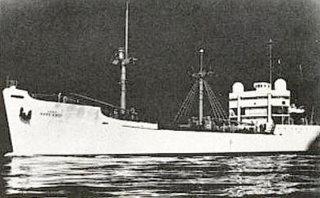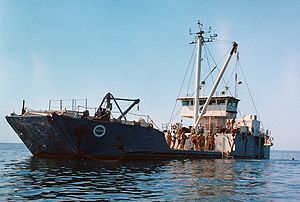
Project Mercury was the first human spaceflight program of the United States, running from 1958 through 1963. An early highlight of the Space Race, its goal was to put a man into Earth orbit and return him safely, ideally before the Soviet Union. Taken over from the US Air Force by the newly created civilian space agency NASA, it conducted 20 uncrewed developmental flights, and six successful flights by astronauts. The program, which took its name from Roman mythology, cost $2.68 billion. The astronauts were collectively known as the "Mercury Seven", and each spacecraft was given a name ending with a "7" by its pilot.

Splashdown is the method of landing a spacecraft by parachute in a body of water. It was used by crewed American space capsules prior to the Space Shuttle program, by the SpaceX Dragon 1 and Dragon 2 capsules and by NASA's Orion Multipurpose Crew Vehicle. It is also possible for the Russian Soyuz spacecraft to land in water, though this is only a contingency. The only example of an unintentional crewed splashdown in Soviet history is the Soyuz 23 landing.

The Lyndon B. Johnson Space Center (JSC) is NASA's center for human spaceflight in Houston, Texas, where human spaceflight training, research, and flight control are conducted. It was renamed in honor of the late US president and Texas native, Lyndon B. Johnson, by an act of the United States Senate on February 19, 1973.

Cape Canaveral Space Force Station (CCSFS) is an installation of the United States Space Force's Space Launch Delta 45, located on Cape Canaveral in Brevard County, Florida.

The Manned Orbiting Laboratory (MOL) was part of the United States Air Force (USAF) human spaceflight program in the 1960s. The project was developed from early USAF concepts of crewed space stations as reconnaissance satellites, and was a successor to the canceled Boeing X-20 Dyna-Soar military reconnaissance space plane. Plans for the MOL evolved into a single-use laboratory, for which crews would be launched on 30-day missions, and return to Earth using a Gemini B spacecraft derived from NASA's Gemini spacecraft and launched with the laboratory.

USNS Kingsport (T-AG-164) was built as SS Kingsport Victory, a United States Maritime Commission VC2-S-AP3 (Victory) type cargo ship. During the closing days of World War II the ship was operated by the American Hawaiian Steamship Company under an agreement with the War Shipping Administration. After a period of layup the ship was operated as USAT Kingsport Victory by the Army under bareboat charter effective 8 July 1948. When Army transports were transferred to the Navy's Military Sea Transportation Service the ship continued as USNS Kingsport Victory (T-AK-239), a cargo transport. On 14 November 1961, after conversion into the first satellite communication ship, the ship was renamed Kingsport, reclassified as a general auxiliary, and operated as USNS Kingsport (T-AG-164).

The landing craft, tank (LCT) was an amphibious assault craft for landing tanks on beachheads. They were initially developed by the Royal Navy and later by the United States Navy during World War II in a series of versions. Initially known as the "tank landing craft" (TLC) by the British, they later adopted the U.S. nomenclature "landing craft, tank" (LCT). The United States continued to build LCTs post-war, and used them under different designations in the Korean and Vietnam Wars.

USS Fort Snelling (LSD-30) was a Thomaston-class dock landing ship of the United States Navy. She was named for Fort Snelling at the confluence of the Minnesota and Mississippi Rivers, for many years the northernmost military post in the land of the Sioux and Chippewa. She was the second ship assigned that name, but the construction of Fort Snelling (LSD-23) was canceled on 17 August 1945.

USAS American Mariner was a United States Army research vessel from January 1959 to 30 September 1963. She was originally assigned to the DAMP Project by the Advanced Research Projects Agency (ARPA) to attempt to collect radar signature data on incoming intercontinental ballistic missiles in the Caribbean, the South Atlantic Ocean, and the Indian Ocean. Her initial operations involved providing radar track on the Atlas missile, which was under development at the time. Subsequently, she provided track on other types of missiles as they proceeded through their development and operational stages. In September 1963 the original contract was transferred to the USAF until the completion of the testing phase in 1964.

SS Twin Falls Victory, named after Twin Falls, Idaho, was a Victory ship built for World War II. Converted to a Missile Range Instrumentation Ship, she was initially operated by the US Air Force as USAF Twin Falls Victory, before coming under US Navy control and being named USNS Twin Falls (T-AGM-11/T-AGS-37). She later had a third career as the training ship SS John W. Brown II.

MV Liberty Star is a formerly NASA-owned and United Space Alliance-operated vessel which primarily served as an SRB recovery ship following the launch of Space Shuttle missions. It also performed tugboat duties and acted as a research platform. In 2012, it was transferred to the U.S. Department of Transportation for use as a training vessel at the United States Merchant Marine Academy as the TV Kings Pointer. Her sister ship is the MV Freedom Star.

MVFreedom Star is a formerly NASA-owned and United Space Alliance-operated vessel which primarily served as an SRB recovery ship following the launch of Space Shuttle missions. It also performed tugboat duties and acted as a research platform.

USNS Range Recoverer (T-AG-161/T-AGM-2/YFRT-524) was a missile range instrumentation ship responsible for providing radar and/or telemetry track data on missiles launched from American launch sites.

USNS Rose Knot (T-AGM-14) was a World War II era United States Maritime Commission small cargo ship built in 1945 and delivered to the War Shipping Administration for operation through agent shipping companies and for periods by the Military Sea Transportation Service (MSTS). In 1957 the ship was transferred to the Air Force and converted into a missile range instrumentation ship which operated as USAFS Rose Knot on the U.S. Air Force's Eastern Test Range during the late 1950s and early 1960s. Rose Knot operated under an Air Force contract with Pan American Airways Guided Missile Range Division headquartered in Cocoa Beach, Florida. In July 1964, all Air Force tracking ships were transferred to MSTS for operation with the Air Force in operational control while the ships were at sea as tracking ships. Rose Knot had special facilities for supporting the human spaceflight program and supported the early crewed flights. The ship was owned by the U.S. government until sold for non-transportation use in 1977.
USS Somerset (AK-212) was an Alamosa-class cargo ship that was constructed for the US Navy during the closing period of World War II. She was later acquired by the US Army in 1946 and the US Air Force in 1957 before being reacquired by the USN as the USNS Coastal Sentry (T-AGM-15), a missile range instrumentation ship.
Peterson Builders Incorporated (PBI) was an American ship building company that constructed small to medium, naval and commercial ships and boats. The company mainly operated from a shipyard in Sturgeon Bay, Wisconsin. Spare parts and logistics were managed from Virginia Beach, Virginia and a ship repair operation in Ingleside, Texas made up part of PBI.

NOAAS George B. Kelez, previously NOAAS George B. Kelez, was an American research vessel in commission in the National Oceanic and Atmospheric Administration (NOAA) fleet from 1972 to 1980. Prior to her NOAA career, she operated under the United States Fish and Wildlife Service′s Bureau of Commercial Fisheries from 1962 to 1970 as US FWS George B. Kelez and the National Marine Fisheries Service from 1970 to 1972 as NOAAS George B. Kelez.

United States Navy submarines, surface ships, and aircraft launch torpedoes, missiles, and autonomous undersea vehicles as part of training exercises. Typically, these training munitions have no warhead and are recovered from the sea and reused. Similarly, new naval weapons under development are launched at sea in performance trials. These experimental units also need to be recovered, in their case to obtain evaluation data. At various points in history, newly manufactured torpedoes were fired as a quality control measure and these, too, had to be recovered before issuing them to the fleet. The U.S. Navy has used a variety of boats to accomplish the retrieval of these test and training munitions. As their missions evolved over the last century they have been variously known as torpedo retrievers, torpedo weapon retrievers, torpedo recovery boats, range support craft, and multi-purpose craft.

The James River Reserve Fleet (JRRF) is located on the James River in the U.S. state of Virginia at near Fort Eustis. James River Reserve Fleet, a "ghost fleet", is part of the National Defense Reserve Fleet. The Reserve Fleet ships in storage, called "mothballed", that can be ready for use if needed. Many are awaiting scrapping due to the age or condition of the ship. Some ships are used for target practice or as artificial reefs. A few ships became museum ships and other sold to private companies. Ships can be readied for use in 20 to 120 days during national emergencies or natural disaster. The U.S. Department of Transportation's Maritime Administration (MARAD) provides oversight of the James River Reserve Fleet. For the United States Navy ships the United States Navy reserve fleets stored these ships and submarines.



















